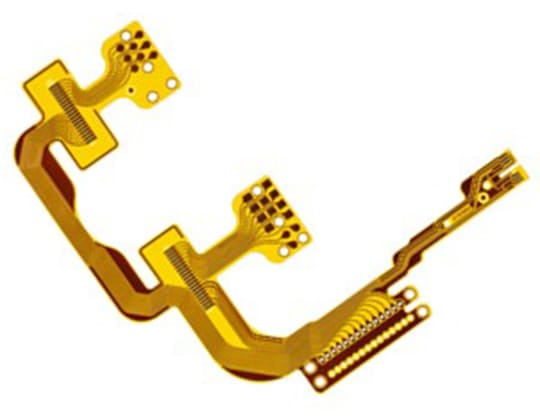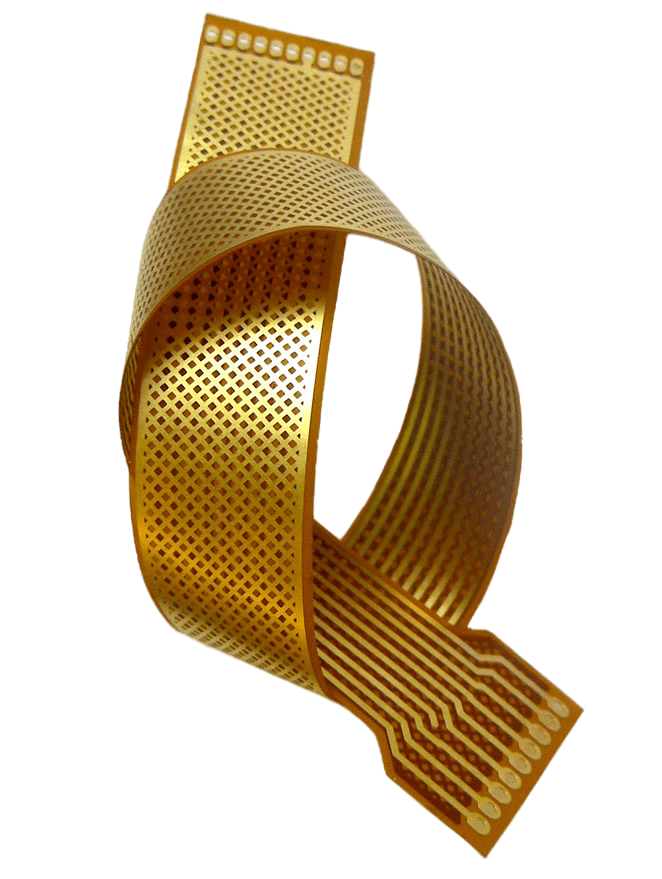Product Benefits
PI Flex material hold unique insulating ability for even very thin substrates, which makes the material excellent for low weight devices with limited space. Connectors and cables are considered a reliability risk in many applications. Flex PCBs can replace or reduce the use of connectors with improved reliability and signal performance as a side effect. They are easy to install and can both hold components and create interconnections in 3D solutions.
Cost Saving
The overall cost of the product can be reduced with flexible solutions by reducing assembly time and by replacing cables and connections.
Fast Assembly
Flex PCB eliminates the need for color code wrap bundles of wire and is much faster to install.
High Durability
Flex PCBs are durable and resistant to shock and vibrations making them suitable for both high-reliability devices and handheld products of every-day use.
Space and Weight Reduction
Cables, connectors, and in some instances rigid PCBs can be replaced by Flex PCBs creating lightweight and very dense interconnection in a reduced space.
Aratek biometric solutions
streamlines identity
management for millions
streamlines identity
management for millions

Aratek biometric solutions
streamlines identity
management for millions
streamlines identity
management for millions
A semi-flex PCB is characterized by its ability to bend or flex to a certain degree while maintaining its structural integrity. This type of PCB is often used to save space in the final product and avoid the use of connectors between two circuit boards. Semi-flex PCBs are manufactured using a combination of traditional PCB fabrication processes such as photolithography, etching, and drilling, as well as specialized techniques for handling the flexible substrate. The final product is a PCB that can bend or flex to a certain degree while maintaining its electrical performance and durability.

Aratek biometric solutions
streamlines identity
management for millions
streamlines identity
management for millions
Base Material: The most common base material used to build a Flexible PCB is Polyimide (PI). It can be used with PTH and is available for the soldering process. PET and PEN can be used for Flexible PCB without soldering needs.
Lines and Spaces: The trace and spacing widths on a Flexible PCB are usually smaller than traditional PCBs to accommodate the limited space and maintain flexibility. A flexible PCB can also be an HDI PCB.
Layer Count: Flexible PCBs can have single-sided, double-sided, and up to 4 layers with a thickness from 25µm to 150µm.
Surface Finish: The surface finish used in Flexible PCBs is usually electroless nickel immersion gold (ENIG)
Lines and Spaces: The trace and spacing widths on a Flexible PCB are usually smaller than traditional PCBs to accommodate the limited space and maintain flexibility. A flexible PCB can also be an HDI PCB.
Layer Count: Flexible PCBs can have single-sided, double-sided, and up to 4 layers with a thickness from 25µm to 150µm.
Surface Finish: The surface finish used in Flexible PCBs is usually electroless nickel immersion gold (ENIG)
Aratek biometric solutions
streamlines identity
management for millions
streamlines identity
management for millions
Flexible PCBs are used in almost every industry that needs space and weight reductions such as automotive, wearable devices, medical, military, instrumentation, avionics, sensors, or industrial controls.

Aratek biometric solutions
streamlines identity
management for millions
streamlines identity
management for millions
A semi-flex PCB is characterized by its ability to bend or flex to a certain degree while maintaining its structural integrity. This type of PCB is often used to save space in the final product and avoid the use of connectors between two circuit boards. Semi-flex PCBs are manufactured using a combination of traditional PCB fabrication processes such as photolithography, etching, and drilling, as well as specialized techniques for handling the flexible substrate. The final product is a PCB that can bend or flex to a certain degree while maintaining its electrical performance and durability.

Aratek biometric solutions
streamlines identity
management for millions
streamlines identity
management for millions
Base Material: The most common base material used to build a Flexible PCB is Polyimide (PI). It can be used with PTH and is available for the soldering process. PET and PEN can be used for Flexible PCB without soldering needs.
Lines and Spaces: The trace and spacing widths on a Flexible PCB are usually smaller than traditional PCBs to accommodate the limited space and maintain flexibility. A flexible PCB can also be an HDI PCB.
Layer Count: Flexible PCBs can have single-sided, double-sided, and up to 4 layers with a thickness from 25µm to 150µm.
Surface Finish: The surface finish used in Flexible PCBs is usually electroless nickel immersion gold (ENIG)
Lines and Spaces: The trace and spacing widths on a Flexible PCB are usually smaller than traditional PCBs to accommodate the limited space and maintain flexibility. A flexible PCB can also be an HDI PCB.
Layer Count: Flexible PCBs can have single-sided, double-sided, and up to 4 layers with a thickness from 25µm to 150µm.
Surface Finish: The surface finish used in Flexible PCBs is usually electroless nickel immersion gold (ENIG)
Aratek biometric solutions
streamlines identity
management for millions
streamlines identity
management for millions
Flexible PCBs are used in almost every industry that needs space and weight reductions such as automotive, wearable devices, medical, military, instrumentation, avionics, sensors, or industrial controls.
Aratek biometric solutions
streamlines identity
management for millions
streamlines identity
management for millions
Industries
Aratek biometric solutions
streamlines identity
management for millions
streamlines identity
management for millions
Industries
Metering
With ultra-modern laboratories and equipment, ICPRUS guarantees long product life and high quality.
Automotive
Top Automotive brands choose ICPRUS to match and exceed the high quality and logistics demands of their industry.
Medical
An ever-increasing amount of companies in the medical industry rely on the Precision from ICPRUS.
Industry
The Industrial Automation sector benefits from ICPRUS’s intimate understanding of the complexity of automation and robotics.
Consumer &
Multimedia
Multimedia
The Industrial Automation sector benefits from ICPRUS’s intimate understanding of the complexity of automation and robotics.
Aerospace
ICPRUS is growing in the aerospace industry because of the benefits offered by our expert services and one-stop solutions.
Aratek biometric solutions
streamlines identity
management for millions
streamlines identity
management for millions
Features
Aratek biometric solutions
streamlines identity
management for millions
streamlines identity
management for millions
Features
Aratek biometric solutions
streamlines identity
management for millions
streamlines identity
management for millions
Technical Data
Do you have any questions? Contact us!


